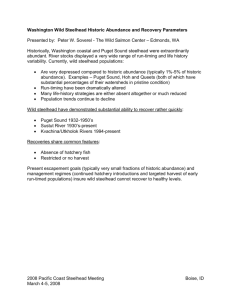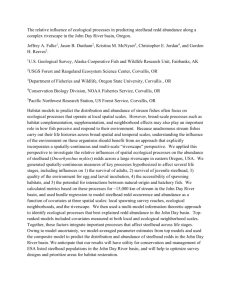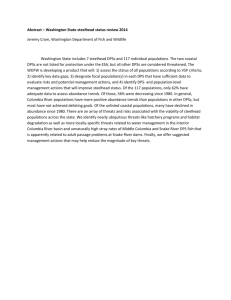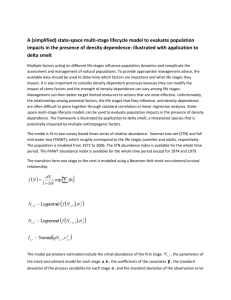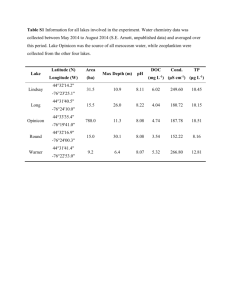Abstract () - Pacific States Marine Fisheries Commission
advertisement
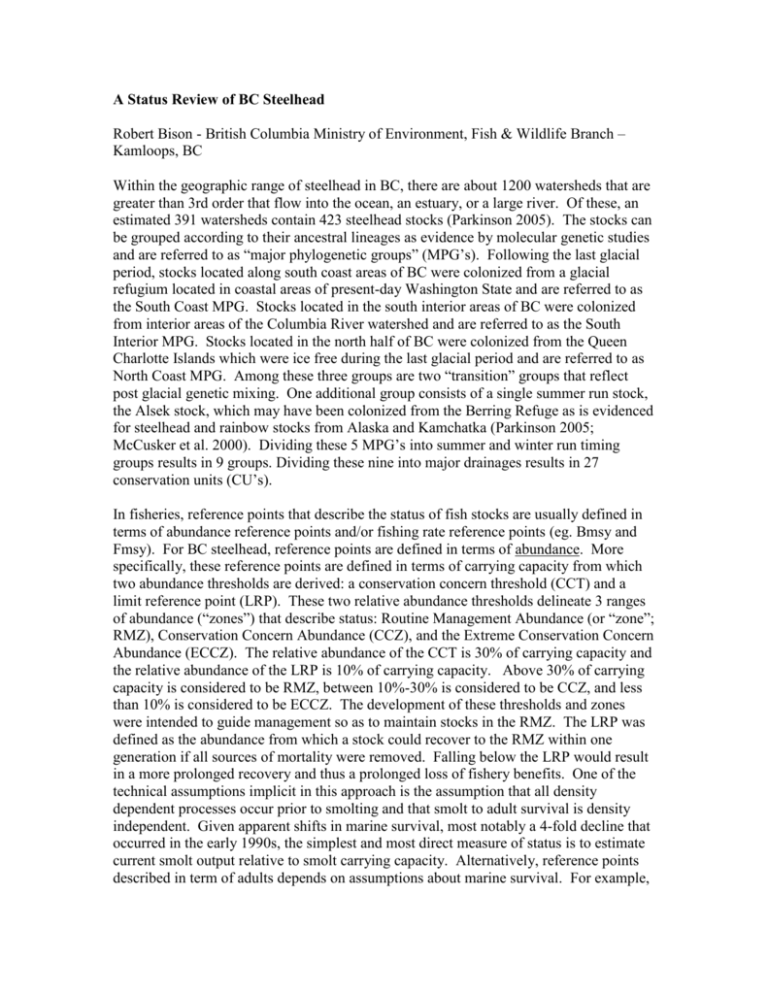
A Status Review of BC Steelhead Robert Bison - British Columbia Ministry of Environment, Fish & Wildlife Branch – Kamloops, BC Within the geographic range of steelhead in BC, there are about 1200 watersheds that are greater than 3rd order that flow into the ocean, an estuary, or a large river. Of these, an estimated 391 watersheds contain 423 steelhead stocks (Parkinson 2005). The stocks can be grouped according to their ancestral lineages as evidence by molecular genetic studies and are referred to as “major phylogenetic groups” (MPG’s). Following the last glacial period, stocks located along south coast areas of BC were colonized from a glacial refugium located in coastal areas of present-day Washington State and are referred to as the South Coast MPG. Stocks located in the south interior areas of BC were colonized from interior areas of the Columbia River watershed and are referred to as the South Interior MPG. Stocks located in the north half of BC were colonized from the Queen Charlotte Islands which were ice free during the last glacial period and are referred to as North Coast MPG. Among these three groups are two “transition” groups that reflect post glacial genetic mixing. One additional group consists of a single summer run stock, the Alsek stock, which may have been colonized from the Berring Refuge as is evidenced for steelhead and rainbow stocks from Alaska and Kamchatka (Parkinson 2005; McCusker et al. 2000). Dividing these 5 MPG’s into summer and winter run timing groups results in 9 groups. Dividing these nine into major drainages results in 27 conservation units (CU’s). In fisheries, reference points that describe the status of fish stocks are usually defined in terms of abundance reference points and/or fishing rate reference points (eg. Bmsy and Fmsy). For BC steelhead, reference points are defined in terms of abundance. More specifically, these reference points are defined in terms of carrying capacity from which two abundance thresholds are derived: a conservation concern threshold (CCT) and a limit reference point (LRP). These two relative abundance thresholds delineate 3 ranges of abundance (“zones”) that describe status: Routine Management Abundance (or “zone”; RMZ), Conservation Concern Abundance (CCZ), and the Extreme Conservation Concern Abundance (ECCZ). The relative abundance of the CCT is 30% of carrying capacity and the relative abundance of the LRP is 10% of carrying capacity. Above 30% of carrying capacity is considered to be RMZ, between 10%-30% is considered to be CCZ, and less than 10% is considered to be ECCZ. The development of these thresholds and zones were intended to guide management so as to maintain stocks in the RMZ. The LRP was defined as the abundance from which a stock could recover to the RMZ within one generation if all sources of mortality were removed. Falling below the LRP would result in a more prolonged recovery and thus a prolonged loss of fishery benefits. One of the technical assumptions implicit in this approach is the assumption that all density dependent processes occur prior to smolting and that smolt to adult survival is density independent. Given apparent shifts in marine survival, most notably a 4-fold decline that occurred in the early 1990s, the simplest and most direct measure of status is to estimate current smolt output relative to smolt carrying capacity. Alternatively, reference points described in term of adults depends on assumptions about marine survival. For example, if a stock and recruitment times series only spans years relatively low marine survival, adult carrying capacity must be rescaled to “average” marine survival as defined in the policy analysis (Johnston et al. 2000) in order to derive the CCT and LRP. Technically, the estimation of carrying capacity for individual stocks has proven challenging in BC. There are few sites where abundance estimation of adult or smolts is either possible, precise enough, or of sufficient duration to estimate smolt carrying capacity empirically with useful precision. But the number of relatively precise adult estimation sites is slowly growing, particularly with the growing use of electronic fish counters. At present, there are 4 fully operational resistivity counters in BC that monitor steelhead (and salmon) abundance. Three are located in the South Coast and South Interior MPG’s (Keogh, Deadman, and Bonaparte) and one is located in the North Coast MPG (Kloya). Steelhead fence operations currently ongoing include one in North Coast MPG (Sustut) and one in South Coast MPG (Little Campbell). Overall, the vast majority of adult abundance estimation or monitoring is done by periodic visual counts during the over-summering period for some early summer run stocks or periodic counts during spawning time, where the uncertainty in the spawner abundance data becomes a technical issue when attempting to empirically estimate carrying capacity. Estimation of smolt output monitoring sites has also proven challenging. There have been many short term projects over the past 30-40 years, but most too short in duration and/or too imprecise to be useful for estimation of smolt carrying capacity. There are 4 presently in continuous operation, all in the South Coast MPG (Cheakamus, Coquitlam, Alouette, Keogh). The Keogh adult/smolt abundance time series is the longest spanning 31 years. The Keogh produces roughly 220-230 smolts/km at capacity (B. Ward, pers. comm.). To date and in the absence of direct empirical estimates, estimation of carrying capacity for some of BC’s steelhead stocks has been derived from assessments based on quantifying the amount of freshwater habitat and transposing these into measures of maximum fry, parr, smolt or adult capacity (Tautz et al. 1992, Riley et al. 1998). Yet others have been derived from adult stock and recruitment relationships as evidenced by time series’ of reported sport fishing catches (Lill 2002). In the absence of alternatives, these “estimates” have been used and have been combined with estimates of current abundance (often fry or adult abundance assessments) to assess status. The geographic distribution of the status of 21 CU’s shows that abundance in the southern third of BC continues to be low, classified as either Conservation Concern or Extreme Conservation Concern. Stocks along the west coast of Vancouver Island have maintained a higher status due to more favourable smolt to adult survival rates. In the northern two thirds of BC, the abundance status is classified higher still, the vast majority of stocks classified as Routine Management abundance, however there is evidence of a recent downward trend or shift in abundance of major runs like Dean, Skeena and Nass occurring or starting about 4 years ago. Recent trends in pacific salmon stocks in the Skeena have shown similar responses with lower than expected returns of sockeye, coho and some chinook stocks in the last 4 years. The northerly extent of this trend or shift is not known for steelhead. Available information is too scant for stock groups like the Stikine and Taku. A trend in the spatial distribution of sport fishing effort over the past 4 decades corroborates with various fishery independent measures of abundance and trends. In general, steelhead angling effort has trended northward focusing particularly on the Skeena River stocks. Also, steelhead angling effort has also become increasingly focused on streams stocked with hatchery steelhead of which there are currently 10 streams in BC. A single fishery, the Chilliwack River steelhead fishery, a fishery stocked with hatchery fish and one where hatchery steelhead harvest is permitted, accounted for 35% of the BC steelhead angling effort in 2006.
